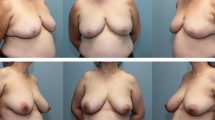Abstract
Background
The VECTRA H1 three-dimensional (3D) imaging system (Canfield Scientific, Parsippany, NJ) enables easy 3D image construction and measurement. Although the number and positions of markers on the skin for image synthesis might affect accuracy of measurements, few studies have mentioned the possibility. This study investigated the accuracy and reproducibility of distance measurements using VECTRA H1, focusing on the number and positions of markers.
Methods
A total of 3, 5, or 7 markers were attached to a female breast model including lateral markers 6 cm from the midline and photographed with VECTRA. Five markers were configured in more two ways, with the lateral markers either positioned 3 cm outside the midline (narrow interval) or 9 cm outside the midline (wide interval). 3D models were created three times under each condition, for a total of 15 models. Differences (measurement error) between measured values on 3D models and actual measured values were verified for six distances, such as distance between the nipples.
Results
The average difference was 11.1 mm with 3 markers (95% confidence interval (CI), 4.38–17.7 mm, p = 0.0028). In comparison, average difference was −0.395 mm (−0.866 to 0.0763 mm, p = 0.095) with 5 markers, and 0.139 mm (−0186 to 0.465 mm, p = 0.379) with 7 markers, all less than 1 mm. Average difference with narrow interval 5 markers was larger than one with wide interval.
Conclusions
In 3D imaging of the breast using VECTRA H1, distance measurements offering clinically satisfactory accuracy can be made by setting appropriate marker conditions.
Level of Evidence V
This journal requires that authors assign a level of evidence to each article. For a full description of these Evidence-Based Medicine ratings, please refer to the Table of Contents or the online Instructions to Authors www.springer.com/00266.





Similar content being viewed by others
References
Tepper OM, Karp NS, Small K et al (2008) Three-dimensional imaging provides valuable clinical data to aid in unilateral tissue expander-implant breast reconstruction. Breast J 14:543–550
Galdino GM, Nahabedian M, Chiaramonte M, Geng JZ, Klatsky S, Manson P (2002) Clinical applications of three-dimensional photography in breast surgery. Plast Reconstr Surg 110:58–70
Losken A, Seify H, Denson DD, Paredes AA Jr, Carlson GW (2005) Validating three-dimensional imaging of the breast. Ann Plast Surg 54:471–478
Kovacs L, Eder M, Papadopulos NA, Biemer E (2005) Validating 3-dimensional imaging of the breast. Ann Plast Surg 55:695–696
Tomita K, Yano K, Hata Y, Nishibayashi A, Hosokawa K (2015) DIEP flap breast reconstruction using 3-dimensional surface imaging and a printed mold. Plast Reconstr Surg Glob Open 3:e316
Wesselius TS, Verhulst AC, Vreeken RD, ** T, Maal TJJ, Ulrich DJO (2018) Accuracy of three software applications for breast volume calculations from three-dimensional surface images. Plast Reconstr Surg 142:853–865
Camison L, Bykowski M, Lee WW, Carlson JC, Roosenboom J, Goldstein JA et al (2018) Validation of the Vectra H1 portable three-dimensional photogrammetry system for facial imaging. Int J Oral Maxillofac Surg 47:403–410
Savoldelli C, Benat G, Castillo L, Chamorey E, Lutz JC (2019) Accuracy, repeatability and reproducibility of a handheld three-dimensional facial imaging device: The Vectra H1. J Stomatol Oral Maxillofac Surg 120:289–296
Wood KL, Zoghbi Y, Margulies I, Ashikari AY, Jacobs J, Salzberg CA (2020) Is the Vectra 3D Imaging System a Reliable Tool for Predicting Breast Mass? Ann Plast Surg 85:S109–S113
O’Connell RL, Khabra K, Bamber JC et al (2018) Validation of the Vectra XT three-dimensional imaging system for measuring breast volume and symmetry following oncological reconstruction. Breast Cancer Res Treat 171:391–398
Author information
Authors and Affiliations
Corresponding author
Ethics declarations
Conflict of interest
The authors declare that they have no conflict of interest.
Human or animal participants
This article does not contain any studies with human participants or animals performed by any of the authors.
Informed consent
Informed consent is not applicable to this type of study.
Additional information
Publisher's Note
Springer Nature remains neutral with regard to jurisdictional claims in published maps and institutional affiliations.
Rights and permissions
About this article
Cite this article
Nakamura, M., Mori, H., Kubota, M. et al. Influence of Marker Number and Position on Accuracy of Breast Measurement With Three-Dimensional Camera. Aesth Plast Surg 46, 1481–1488 (2022). https://doi.org/10.1007/s00266-021-02629-1
Received:
Accepted:
Published:
Issue Date:
DOI: https://doi.org/10.1007/s00266-021-02629-1




